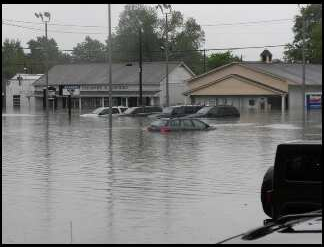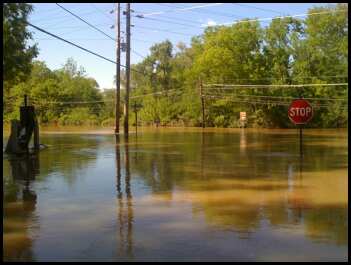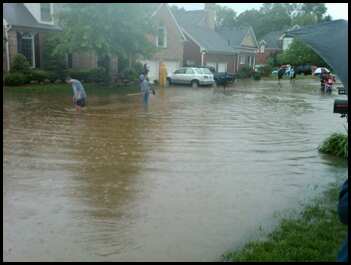
Fortunately, this year’s flooding throughout the Red River Valley, while once again extensive, has not caused anywhere near the level of damage we saw last year — let alone the catastrophic destruction that occurred in 1997.
And although this is cause for jubilation throughout the region, the city of Fargo will remain cautious until the flood waters fully recede.
Officials in North Dakota and Minnesota are catching their breath Monday, if only briefly, after the Red River crested over the weekend.
Despite the river peaking at 36.99 feet — 19 feet above flood level — Sunday morning, the region will have to contend with high water for a while.
“It’ll be about a week, so we’re just going to continue to monitor things and kind of wait as that water very, very slowly goes down,” said Robyn Litke, spokeswoman for Fargo, North Dakota.
“We are just continuing to maintain our dikes and just continuing the dike patrols. It is expected that we will stay well above major the major flood stage of 30 feet for about the next week or maybe a little bit longer.”
Knock on wood, but hopefully this means the region has sidestepped another major disaster.
The perhaps-even-better news came later in the day, however, as the Washington Post has revealed that a long-term, permanent solution to protect the region may soon be realized.
The answer? A 36-mile channel that would cost $1.3 billion.
Local governments say the best option is a massive 36-mile-long channel but the project’s $1.3 billion cost and long construction timetable means that spring flooding is likely to remain a headache for another decade.
For projects like this (as well as proposed floodgates that could provide near-impenetrable protection for New Orleans), the pricetags always sound completely reasonable to me. For a project like this — which would protect hundreds of thousands of people, safeguard billions of dollars in assets and provide peace of mind to dozens of municipalities — even a figure like $1.3 billion seems like something that should just be immediately rubber-stamped, with construction beginning tomorrow.
Or, better yet, last year.
Admittedly, I have not yet looked into all the other potential barriers (no pun intended) to get this done other on top of cost, but especially when we’re in the midst of a recession featuring an unemployment rate hovering around 10%, a public works project that both creates (or at least guarantees) jobs and a provides meaningful benefit to the region seems like a no-brainer.
Of course, this isn’t a sensible world where logical and ambitious-yet-achievable endeavors always come to fruition.
This is a world of politics.
“I think we have been very cohesive,” Fargo city commissioner Brad Wimmer said of the various governments. “But we haven’t written any checks yet. It’s not a done deal.”
The U.S. Army Corps of Engineers, which will manage the final project, said the federal government would cover $565 million of the costs, leaving state and local governments to pay about $735 million. The spirit is there, especially since local governments are already dealing with the costs of flooding. The city of Fargo alone has spent nearly $31 million for flood fighting and cleanup since 1997, including an estimated $3 million this year, Fargo finance director Kent Costin said.
But with such an expensive project, the quibbling has already started. Supporters of the project will be asking for money from one state (Minnesota) that is broke and another state (North Dakota) that has a billion-dollar surplus.
The diversion has set off a debate in North Dakota because despite having extra money, a traditional divide between rural and urban lawmakers makes approving its funding not quite a done deal.
“We have to make it sellable to everybody across the state,” said North Dakota state Sen. Tim Flakoll, R-Fargo.
Many North Dakota lawmakers are thrifty and hesitant to spend the surplus for fears it will run out. Some are also resistant to spending so much money on a single project that benefits only Fargo, the state’s largest city.
Of course they are.
In the meantime, the Paleolithic Era-level technology of piling up sandbags and clay along the shore will continue to be used as a means to try to save lives and protect homes. But did you ever wonder what happens to all those sandbags after they aren’t needed anymore?
NPR did.
the bags are mostly destroyed — the wear and tear takes a lot out of them. But lots of sand gets spread on fields and used in road projects. Some, if it has been contaminated with sewage or chemicals, has to go to treatment facilities. And a substantial amount gets saved for use the next year.
Getting rid of it all isn’t always cheap. Last year, as InForum reported, about 2.5 million sandbags were filled and placed in Fargo alone to keep back the Red. One contract for removal cost the Army Corps of Engineers $1 million.
But often, as Moorhead city manager Micahel Redlinger explained to All Things Considered host Melissa Block this afternoon, residents themselves help take down the walls. And Moorhead saves as much of the sand as it can. About half of the 15,000 yards of sand the city used this year was material saved from last year’s flood control effort.
The folks in Moorhead filled about 350,000 bags this year, well below last year’s 2.5 million that were used to keep back the record high crest.
Hey … At least they’re recycling.
And be sure to head over to NPR to listen to an extended audio interview with Redlinger that aired today during All Things Considered.

Beep. Beep. Make way for the Sandbag Express. Headed to the Red River Valley — yet again this year. (Both photos: Michael Rieger/FEMA)





